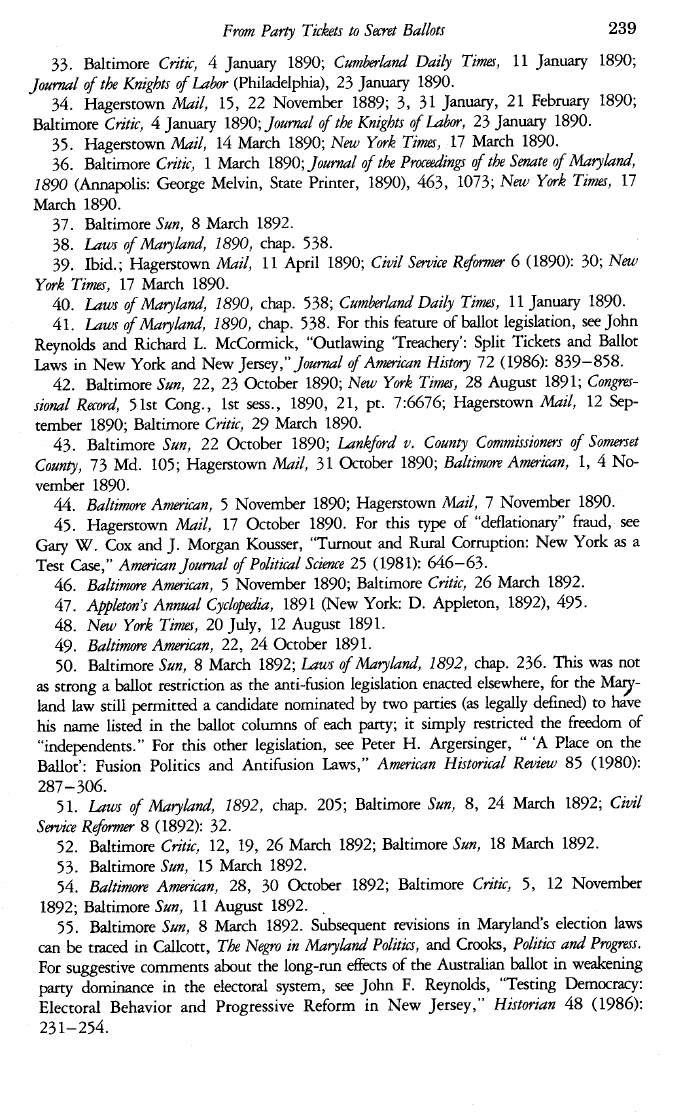|
From Party Tickets to Sant Ballots 239
33. Baltimore Critic, 4 January 1890; Cumberland Daily Timer, 11 January
1890;
Journal of the Knights of Labor (Philadelphia), 23 January 1890.
34. Hagerstown Mail, 15, 22 November 1889; 3, 31 January, 21 February 1890;
Baltimore Critic, 4 January 1890; Journal of the Knights of Labor, 23
January 1890.
35. Hagerstown Mail, 14 March 1890; New York Timer, 17 March 1890.
36. Baltimore Critic, 1 March 1890; Journal of the Proceedings of the
Senate of Maryland,
1890 (Annapolis: George Melvin, State Printer, 1890), 463, 1073; New York
Timer, 17
March 1890.
37. Baltimore Sun, 8 March 1892.
38. Laws of Maryland, 1890, chap. 538.
39. Ibid.; Hagerstown Mail, 11 April 1890; Civil Service Refornzer 6
(1890): 30; New
York Timer, 17 March 1890.
40. Laws of Maryland, 1890, chap. 538; Cumberland Daily Timer, 11 January
1890.
41. Laws of Maryland, 1890, chap. 538. For this feature of ballot
legislation, see John
Reynolds and Richard L. McCormick, "Outlawing `Treachery': Split Tickets
and Ballot
Laws in New York and New Jersey," Journal of American History 72 (1986):
839-858.
42. Baltimore Sun, 22, 23 October 1890; New York Times, 28 August 1891;
Congrns-
sional Record, 51st Cong., 1st sess., 1890, 21, pt. 7:6676; Hagerstown
Mail, 12 Sep-
tember 1890; Baltimore Critic, 29 March 1890.
43. Baltimore Sun, 22 October 1890; Lankford v. County Commissioners of
Somerset
County, 73 Md. 105; Hagerstown Mail, 31 October 1890; Baltimore American,
1, 4 No-
vember 1890.
44. Baltimore American, 5 November 1890; Hagerstown Mail, 7 November 1890.
45. Hagerstown Mail, 17 October 1890. For this type of "deflationary"
fraud, see
Gary W. Cox and J. Morgan Kousser, "Turnout and Rural Corruption: New York
as a
Test Case," American Journal of Political Science 25 (1981): 646-63.
46. Baltimore American, 5 November 1890; Baltimore Critic, 26 March 1892.
47. Appleton's Annual Cyclopedia, 1891 (New York: D. Appleton, 1892), 495.
48. New York Times, 20 July, 12 August 1891.
49. Baltimore American, 22, 24 October 1891.
50. Baltimore Sun, 8 March 1892; Laws of Maryland, 1892, chap. 236. This
was not
as strong a ballot restriction as the anti-fusion legislation enacted
elsewhere, for the Mat
land law still permitted a candidate nominated by two parties (as legally
defined) to have
his name listed in the ballot columns of each party; it simply restricted
the freedom of
"independents." For this other legislation, see Peter H. Argersinger, " 'A
Place on the
Ballot': Fusion Politics and Antifusion Laws," American Historical Review
85 (1980):
287-306.
51. Laws of Maryland, 1892, chap. 205; Baltimore Sun, 8, 24 March 1892;
Civil
Service Reformer 8 (1892): 32.
52. Baltimore Critic, 12, 19, 26 March 1892; Baltimore Sun, 18 March 1892.
53. Baltimore Sun, 15 March 1892.
54. Baltimore American, 28, 30 October 1892; Baltimore Critic, 5, 12
November
1892; Baltimore Sun, 11 August 1892.
55. Baltimore Sun, 8 March 1892. Subsequent revisions in Maryland's
election laws
can be traced in Callcott, The Negro in Maryland Politics, and Crooks,
Politics and Progress.
For suggestive comments about the long-run effects of the Australian ballot
in weakening
party dominance in the electoral system, see John F. Reynolds, "Testing
Democracy:
Electoral Behavior and Progressive Reform in New Jersey," Historian 48
(1986):
231-254.
|

